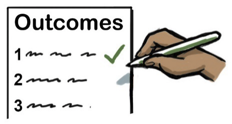National Flood Resilience Strategy: Easy Read
The easy read version of the National Flood Resilience Strategy.
Flood Resilience Strategy Easy Read version
Introduction

Flooding is Scotland's biggest climate challenge.

Flood resilience means we are better at dealing with flooding when it happens. Being flood resilient means flooding does not cause danger to people, damage to property or disrupt daily life.

The climate is the weather we expect to have. Climate change means we will have warmer temperatures, more heavy rain and drier summers. Sea levels are also rising.

Floods like we saw in the east of Scotland in October 2023 during Storm Babet show that global warming is already influencing weather events here at home.

Climate change will make sea levels, rainfall levels and river flows increase over the coming decades. By 2080 the number of properties at risk of flooding in Scotland will rise from 284,000 to almost 400,000.
Vision

Our vision for flood resilience in Scotland through to 2045 and beyond is:

Our people and places are ready for increased flooding and we are adapting to a changing climate. We are making places that are ready to deal with flooding in ways that are inclusive and fair.

The Strategy sets out our Outcomes. These are the goals we want to reach. It also sets out Guiding Principles we will work to and our Priority Actions. These are the things we think we need to do first.
Outcomes

The Strategy has three Outcomes based on the themes of People, Places and Processes.

People outcome:
People and communities are involved in making our places flood resilient.

We will work with partners to find out how people and communities can be involved in decision making and planning for flood resilience.

Places outcome:
The best examples and evidence are used to make decisions when making places flood resilient.

We will work with partners to come up with the best ways to plan better flood resilience.

Processes outcome
All our places are made with flood resilience in mind.
Lots of organisations are involved in doing this work.

We will work with partners to come up with better processes for flood resilience.
Guiding Principles

The Strategy's four guiding principles are:

The focus of action will change from 'fixing flooding problems' to creating flood resilient places.

Flood resilience is part of community resilience and part of adapting to climate change.

All our flood resilience activities will be fair and will benefit everyone equally.

Everyone benefits from flood resilient places, and we all have a part to play.
Priority Actions

To help reach our outcomes we have set out six priority actions that we need to do with partners through a Strategy plan.

Set up a flood advisory service
The Flood Advisory Service will give support and advice on building flood resilience to organisations and communities. They will organise things like flood defences.

Involve and support communities
We will make guidelines for supporting communities to get involved in flood resilience. We will support people to get involved and make their communities more flood resilient.

Improve land-use for flood resilience
Learn more about how our towns and countryside can be made more flood resilient. Work with more organisations and land-owners to find ways of improving our flood resilience.

Support a wider range of flood actions
We will look at our budgets to see how much money we can spend on flood actions including smaller flood protection schemes and property level flood resilience.

We will find new organisations to work with in the public and private sector who can help build flood resilient places.

Use facts and evidence to improve flood resilience
We will look at better ways to present facts and evidence about climate change. This will help with decision making about flood resilience.

We will use this information to raise community awareness of flooding. This will help communities to play their part in flood resilience.

Support long-term planning for our most exposed communities
We will support communities where long-term flood defences might not be possible.

We will look at how we can get better warnings about coastal storm damage and areas that will be worse affected by coastal change.
Putting the Strategy into action

Reaching our outcomes and the Flood Resilience Strategy vision will depend on a new level of working together.

The next stage will be to make a plan that enables the Scottish Government and other organisations to work together to deliver outcomes.

This will include the six priority action areas starting with setting up the Flood Advisory Service. This service will be the key to our flood resilience.
Contact
Email: Flooding_Mailbox@gov.scot
There is a problem
Thanks for your feedback